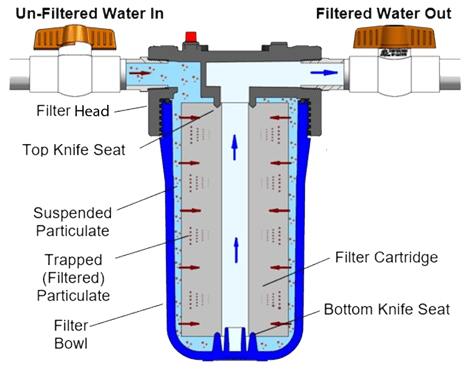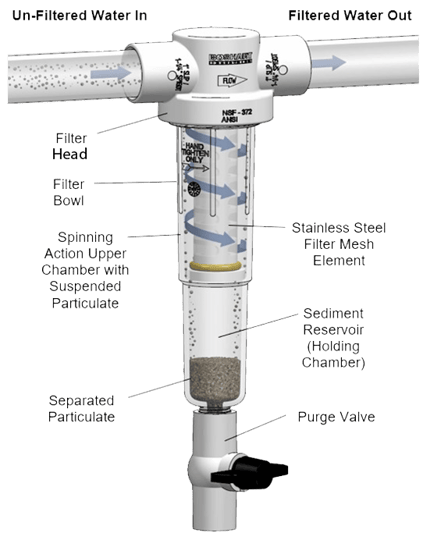In previous blogs, we have talked about the differences between a traditional sediment filter and a spin out sediment filter based on their components. But another differences between the two, is actually the way they work. Very similar, but still different.
In this blog, we break down how a traditional filtration system works and how a spin out sediment filtration system works, helping you determine which one to use in your filtration system.
To take a look at our blog, What are the Differences between a Traditional Sediment Filter & a Spin Out Sediment Filter or Separator? click here.
How Does Traditional Water Filtration Work?

The most common types of water filtration found in residential and some commercial applications are traditional water filter housings that have a filter cartridge installed. Typically, these types of filtration systems are installed at the point-of-entry (POE) into a home.
Unfiltered water whether sourced from a municipal source or a well, is connected to the inlet of the filter body. The water is directed down into the filter bowl, on the outside of the filter cartridge. The systems pressure forces the water to flow through the filter cartridge media, into the open center core. The now filtered water flows up the center of the cartridge towards the filter body and then is pushed out of the outlet connection.
The micron rating of the filter cartridge is what determines the size of the particulate that it will stop. The micron rating is the measurement of the size of the holes that allow water or fluid to pass through, while stopping sediment larger than the hole. This holds true for any filter cartridge you choose.
How Does Spin Out Water Filtration Work?

In a case where there is a large amount of sediment in the water, if using a traditional sediment filter, the cartridge may get clogged prematurely resulting in reduced flow and low pressure. By installing a spin out sediment filter or separator as a pre filter plumbed in series before the traditional sediment filter will eliminate most of the large amounts of sediment while also saving you money from replacing your cartridge too often.
Spin out sediment filters and separators have similar flow paths as the traditional filter but operate differently. In a spin out filter application, unfiltered water is connected to the inlet of the filter body and the water is directed down into the filter bowl, on the outside of the element. The filter body is specifically designed to allow a rapid spinning action inside the filter bowl, making the heavy sediment and other particulate separate from the water and forcing it against the wall of the filter bowl. Using centrifugal force, the heavy particulate will slowly drop to the bottom of the bowl in the sediment hold chamber, separating the sediment from the water in the upper chamber. The system pressure will eventually force the water through the mesh filter into the open center core. The water will travel up the center of the element and leave through the outlet connection.
Depending on the amount of sediment you need to remove, the spin out filter may do the trick as a 1000 mesh cartridge will remove particulate down to roughly 15 microns.
If you want to remove finer silt or clay from the water, you can install a second "finishing filter" (traditional water filter) to take out the very fine particulate.
In Summary:
Both traditional filters and spin out sediment filters do eliminate particulate similarly but depending on the amount you need removed, it will determine which one you should use. Or in some cases, it may be a good idea to use both.
Have further questions about this subject?

Head over to Boshart's Knowledge Base: technical product information, guidelines, and more.


![[Video] Water Filtration vs Water Treatment & Why They are Not the Same](https://blog.boshart.com/hubfs/2022-04-27%20Filtration%20Promo%20Photos-12-1.jpg)


SHARE